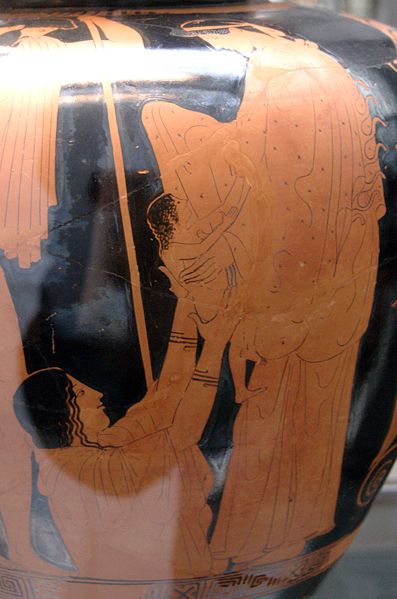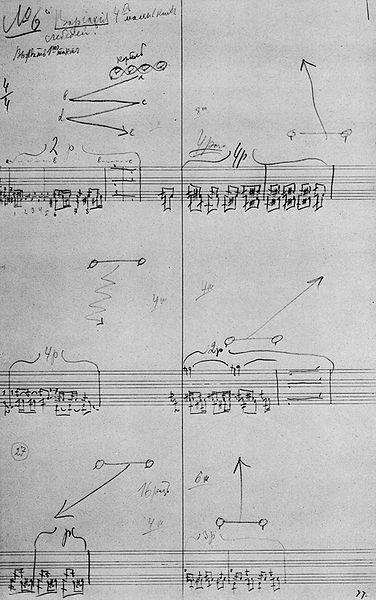I’ve been puzzling over an early myth of sacrifice: a kind of coming of age ritual for Athenians. It involves the child born to Athena, or rather born through the surrogate of the earth. Athena, in turn gives a closed basket or box (presumably holding the child) to three young maidens, who are entrusted with not looking inside. Clearly this is not going to go well. The versions vary every which way, but apparently one of the maidens takes a peak, and either fleeing out of horror (snakes may be involved, perhaps a half beast), or out of guilt, throws herself off a cliff. The remaining maidens follow suit, either out of fear, complicity, or solidarity. The motives remain mysterious. But that just goes to show that the essential point is that they throw themselves off the cliff.
The Athenians had a whole ritual enactment, as a kind of coming of age. And it strikes me that even beyond the place they make for it, this speaks to a deep educational structure. Let’s just be cursory: a black box with dangerous knowledge, a sacrifice on the cusp of a transition in the life of the city (and one in which the principle participant doesn’t survive, but in which the community itself is healed) but perhaps most interestingly, the spreading of sacrifice, so that one is called to jump despite never being initiated into the mystery in the first place. It is one thing if we are called to sacrifice for an education in which we directly relate, but is not what is being set up here a notion of sacrifice that is predicated not on being given the secret oneself, but on the notion that someone else must have been given it? The beauty of this is that it scales up. A few significant sacrifices stand for every young woman coming of age. But also that it operates without any direct connection to knowledge. What is exchanged is the notion of exchange. Like the emperor’s new clothes, we prefer to take comfort in pretending we, like everyone else, have been initiated. An actual disclosure would be most problematic.
The Black Swan
Anyway, I bring all of this up because I just watched the movie Black Swan, by Darren Aronofsky: a masterful play on Tchaikovsky’s ballet Swan Lake, which is of course a story of the ultimate sacrifice for love in the face of societal norms, and the challenge of substitutions. The white swan must die for love, or rather, die to show that she is precisely not interchangeable with the black swan. Which is to say, in the name of something greater than a simple social transaction, while still confirming the binding force of the social. The only way out is death.
It is, of course, a story of fidelity. Take the setup to The White Duck, an early Russian tale that it is in part based on:
A king has to leave his newly-wed wife for a journey. He sternly warns her against leaving the women’s quarters and listening to bad advice. A woman lures her into the garden and into a pool, and turns her into a white duck, herself taking the queen’s own form and place. The king returned but did not know her.
At first, in Aronofsky’s movie version, it seemed that what was precisely missing was the question of love. Set in the cold striving of a ballet company, any real connection is strictly missing (yet dreamed of). But this is precisely the power of his telling. It shows that love, like the black box, must operate as a dream, all the more powerful for being foiled, while what is really being enacted is a question of control. In that sense, Aronofsky’s accomplishment is extraordinary, building a world in which the idea of freedom, of relation, of love, can only function by way of being postulated and rigorously excluded. And his twist is interesting: rather than being forced to differentiate herself from the black impostor, she must learn to truly become her. The insight is to see that the white swan is not simply the forbidden tragic love prohibited by society, but rather that she is marked even more deeply by control. The cold aloof precision of the white swan stands for what the court only pretends to, and she will honor the transaction more authentically, even unto death. Thus the constant refrain of the movie, the challenge to the snow queen: you must learn to lose control.
The irony, however, is that the movie provides no actual exit. The world of the ballet is wrought iron. Even “abandon” is calculated. And this is the extraordinary, claustrophobic feat of it. It is a movie about what Control imagines Relaxation to look like, and how impossible and necessary it is. And how it could only culminate in the ultimate sacrifice. It builds, of course, because what is missing is a notion of relaxation in itself. It is instead a whispered rumor of what must live within the black box. The more it is suppressed the more it threatens to emerge, but as the violent other. The machine dreams of its own disruption. (Aronfosky has mastered the theme he picked up in the early Pi.) It build and builds through frustration.
If the refrain is, you must learn to lose control, it is always followed by another layer of control. Thus: if you don’t learn to lighten up, you will blow your big chance.
Nice.
In this regard ballet is no mere backdrop. It has long suffered from the challenge of how to simulate effortlessness and grace through the most brutal and rigorous means. (But I will control my instincts as a movement educator, here.) I want to merely point out that school is also a quintessential backdrop for this narrative. And the challenge as teachers is that the context and dream are often at odds. Whether we shout for people to chill out, or wish that students would exhibit a passion for knowledge while we ourselves are complicit in the structures that strictly exclude this as anything other than a dream. We resort to the most at odds of strategies. We exhort honesty, but punch it home, for example, with the most deceitful of threats.
The challenge that Aronofsky’s Black Swan presents us with is that in no easy way can we simply imaging that the protagonist is at the mercy of the manipulative adults, but that the blurring of reality suggests even these might be a kind of dream world generated by the cold force of the white swan herself, wrapping herself in control, pushing it to the brink. But if we cannot displace the blame so easily outward, that leaves us with the question of what it would take to generate meaningful alternatives ourselves. Us white swans, dreaming of escape, doing it the only way we can imagine.
Would we not have to rethink our contexts? Assess how much we ourselves believe in our dreams? Would we not have to think relaxation in and of itself, rather than as a subset or extension of control?
Would we not have to rethink fidelity?

